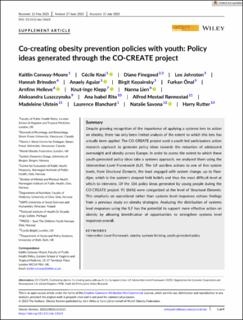| dc.contributor.author | Conway-Moore, Kaitlin | |
| dc.contributor.author | Cecile, Knai | |
| dc.contributor.author | Finegood, Diane | |
| dc.contributor.author | Johnston, Lee | |
| dc.contributor.author | Brinsden, Hannah | |
| dc.contributor.author | Aguiar, Anaely | |
| dc.contributor.author | Kopainsky, Birgit | |
| dc.contributor.author | Onal, Furkan | |
| dc.contributor.author | Helleve, Arnfinn | |
| dc.contributor.author | Klepp, Knut-Inge | |
| dc.contributor.author | Lien, Nanna | |
| dc.contributor.author | Luszczynska, Aleksandra | |
| dc.contributor.author | Rito, Ana Isabel | |
| dc.contributor.author | Mestad Rønnestad, Alfred | |
| dc.contributor.author | Ulstein, Madeleine | |
| dc.contributor.author | Blanchard, Laurence | |
| dc.contributor.author | Savona, Natalie | |
| dc.contributor.author | Rutter, Harry | |
| dc.date.accessioned | 2023-10-03T08:47:43Z | |
| dc.date.available | 2023-10-03T08:47:43Z | |
| dc.date.created | 2023-09-27T15:47:32Z | |
| dc.date.issued | 2023 | |
| dc.identifier.issn | 1467-7881 | |
| dc.identifier.uri | https://hdl.handle.net/11250/3093690 | |
| dc.description.abstract | Despite growing recognition of the importance of applying a systems lens to action on obesity, there has only been limited analysis of the extent to which this lens has actually been applied. The CO-CREATE project used a youth-led participatory action research approach to generate policy ideas towards the reduction of adolescent overweight and obesity across Europe. In order to assess the extent to which these youth-generated policy ideas take a systems approach, we analyzed them using the Intervention Level Framework (ILF). The ILF ascribes actions to one of five system levels, from Structural Elements, the least engaged with system change, up to Paradigm, which is the system's deepest held beliefs and thus the most difficult level at which to intervene. Of the 106 policy ideas generated by young people during the CO-CREATE project, 91 (86%) were categorized at the level of Structural Elements. This emphasis on operational rather than systems level responses echoes findings from a previous study on obesity strategies. Analyzing the distribution of systems level responses using the ILF has the potential to support more effective action on obesity by allowing identification of opportunities to strengthen systems level responses overall. | en_US |
| dc.language.iso | eng | en_US |
| dc.publisher | Wiley | en_US |
| dc.rights | Navngivelse-Ikkekommersiell 4.0 Internasjonal | * |
| dc.rights.uri | http://creativecommons.org/licenses/by-nc/4.0/deed.no | * |
| dc.title | Co-creating obesity prevention policies with youth: Policy ideas generated through the CO-CREATE project | en_US |
| dc.type | Journal article | en_US |
| dc.type | Peer reviewed | en_US |
| dc.description.version | publishedVersion | en_US |
| dc.rights.holder | Copyright 2023 the authors | en_US |
| dc.source.articlenumber | e13623 | en_US |
| cristin.ispublished | true | |
| cristin.fulltext | original | |
| cristin.qualitycode | 1 | |
| dc.identifier.doi | https://doi.org/10.1111/obr.13623 | |
| dc.identifier.cristin | 2179561 | |
| dc.source.journal | Obesity Reviews | en_US |
| dc.identifier.citation | Obesity Reviews. 2023, 24 (S2), e13623. | en_US |
| dc.source.volume | 24 | en_US |
| dc.source.issue | S2 | en_US |

